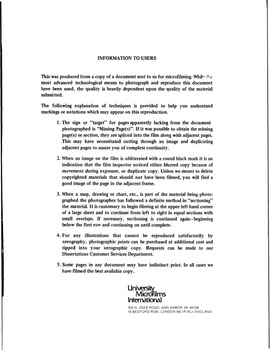| dc.contributor.author | Bryjak, George J. | en_US |
| dc.date.accessioned | 2013-08-16T12:28:05Z | |
| dc.date.available | 2013-08-16T12:28:05Z | |
| dc.date.issued | 1980 | en_US |
| dc.identifier.uri | https://hdl.handle.net/11244/4744 | |
| dc.description.abstract | This dissertation examines the role of deterrence theory and the subjective component of anomie theory (anomia) as explanations for two types of rule violating behavior: cheating and stealing. While the primary purpose of this study is to ascertain the explanatory power of these theories, a secondary goal is to investigate the possibility of an eventual theoretical synthesis of the deterrence and anomie perspectives. | en_US |
| dc.description.abstract | It is concluded, on the basis of our analysis, that anomia as operationalized and measured in this study, is not the generative factor that best accounts for classroom cheating and stealing behavior. Possible explanations for the observed weak relationship between anomia and the rule violating behavior are offered. Looking at the inhibitory variables, the best predictor of self reported violations was found to be moral commitment. Implications of this finding are also discussed. | en_US |
| dc.description.abstract | In regard to the hypothesis of central importance, we discovered that anomia need not be present for the occurrence of self reported violations. In other words, anomia is not a necessary condition for deviant behavior as we had predicted. We also learned that prohibitive factors do not influence rule violating behavior solely under the condition of high anomia. The central hypothesis of this research was, therefore, rejected. | en_US |
| dc.description.abstract | In a move toward the integration of anomie and deterrence theory, we advanced three hypotheses. The final, and most important hypothesis is as follows: People will engage in rule violating behavior only under the pressure of the generative factor (anomia). In other words, the generative factor is a necessary condition for deviance. Thus, prohibitive factors influence rule violating behavior only when anomia is high. When anomia is low, there should be no relationship between prohibitive factors and rule violating behavior. | en_US |
| dc.format.extent | vii, 161 leaves ; | en_US |
| dc.subject | Sociology, Criminology and Penology. | en_US |
| dc.title | Deterrence theory and anomie / | en_US |
| dc.type | Thesis | en_US |
| dc.thesis.degree | Ph.D. | en_US |
| dc.thesis.degreeDiscipline | Department of Sociology | en_US |
| dc.note | Source: Dissertation Abstracts International, Volume: 41-05, Section: A, page: 2303. | en_US |
| ou.identifier | (UMI)AAI8024412 | en_US |
| ou.group | College of Arts and Sciences::Department of Sociology | |
